Aeroballistic rocket Douglas WS-138A / GAM-87 Skybolt (USA)
In the second half of the fifties, the US Air Force encountered some difficulties in the field of intercontinental ballistic missiles, which forced them to pay more attention aviation means of destruction. As part of the Weapon System 199 program, two promising aeroballistic missiles were created for existing bombers. However, the flight range of the WS-199B Bold Orion and WS-199C High Virgo products was 1100 and 300 km, respectively - less than required to effectively solve combat missions and hit targets on the territory of a potential enemy, covered by powerful air defense.
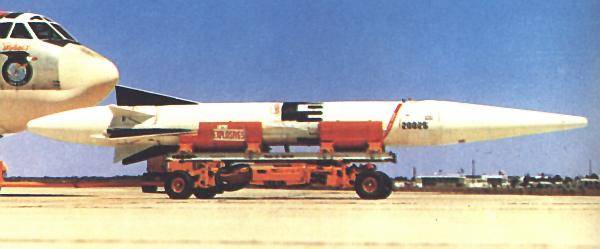
WS-138A / GAM-87 missile on a transport trolley. Photo US Air Force
By the beginning of the sixties, the Air Force Command, after seeing the results obtained, decided to abandon the experimental samples in favor of a completely new rocket, created using their ideas and solutions. Already at the beginning of 1959, an order appeared to design such weapons. Soon the main contractor was chosen - the aircraft development company received the Douglas aircraft manufacturing company. Curiously, she had not previously participated in the WS-199 program, but her version of the new project looked the most successful.
Initially, the project was given the faceless designation WS-138A or Weapon System 138A (“Weapon System“ 138A ”). Later, the military designation GAM-87 and the name Skybolt appeared. After the introduction of a new range of missile weapons introduced the designation AGM-48. Also at the testing stage, experienced missiles were designated as XGAM-87 or XAGM-48. The letter “X” indicated the current stage of the project.
In 1959-60 - long before the appearance of real rockets - Skybolt products became the subject of an export contract. During this period, the UK faced serious difficulties in developing the Blue Streak ballistic missile. After lengthy disputes, the British military and political leadership decided to abandon such weapons. Instead of their own ballistic missiles, nuclear forces were planned to be reinforced with US-made WS-138A products. In March, 1960, the countries agreed to supply 144 missiles. The first contract for a batch of 100 products was signed two months later.
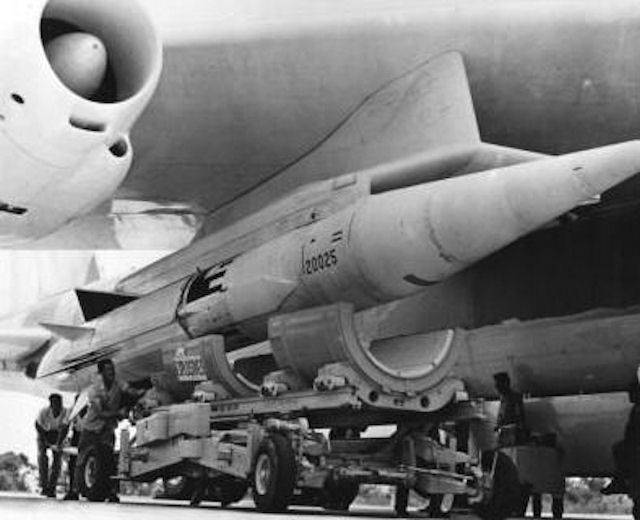
Suspension of the Skybolt rocket on the carrier. Photo by Globalsecurity.org
The shape of the future WS-138A rocket was determined taking into account the developments in the WS-199 program. The most successful was considered a two-stage scheme using only solid-fuel engines. The rocket was proposed to be equipped with a high-power nuclear warhead, the dimensions and mass of which corresponded to its capabilities. The inertial navigation system, traditional for ballistic missiles of the time, was planned to be supplemented with astrocorrection tools, which made it possible to increase the accuracy of shooting.
The main element of the WS-138A rocket was a metal body, built on the basis of the frame. The body was equipped with a long conical head fairing with a rounded bow. In the early stages of testing, a fairing with a short cone and a cylindrical wall of small diameter was also used. The main part of the body, divided into two stages, had the shape of a cylinder with several protruding longitudinal shells on the outer surface. In the tail of the rocket were eight planes of a triangular shape. Larger swept planes served as stabilizers. Between them were placed rotary aerodynamic control surfaces, differing in smaller sizes. The tail section of the hull during the flight on the pylon of the carrier was covered with a drop-shaped fairing with an ogival shape. Steps, head and fairing were connected to each other using pyrobolts.
The rocket did not have a complex layout. The volumes inside the head fairing were given for the installation of the warhead and control systems. All other compartments of both stages contained a pair of large solid propellant engines. In the tail section of the first stage, at the level of the planes, steering machines were also located.
The power plant for the Skybolt rocket was developed by Aerojet. For the first stage, the XM-80 engine was developed, for the second - the XM-81. Unlike previous projects, this time the engines were not borrowed from existing missiles, but were developed specifically for the new product in accordance with the requirements.
Northrop was appointed as a subcontractor responsible for the creation and production of guidance systems. On the basis of existing developments, a new inertial navigation system was developed, integrated into the autopilot. To improve the accuracy of shooting for the first time in American practice, an astrocorrector was used. Management in flight was proposed to carry out in different ways. The first stage was equipped with aerodynamic rudders, while the second was used a movable engine nozzle, changing the thrust vector.
In the basic configuration intended for the USAF, the WS-138A rocket was supposed to carry a thermonuclear warhead of the W59 type. This product had a length of 1,2 m with a maximum diameter of 415 mm and weighed about 250 kg. The power of its charge was determined at the level of 1 Mt. Especially for the new rocket, General Electric has developed a new building with the means of protecting the warhead against external influences during descent to the target.
The British military wanted to buy missiles with different combat equipment. In their case, the Skybolt rocket should have been equipped with a fusion charge such as Red Snow with an 1,1 Mt capacity. This product was different from the American W59, but did not require significant processing of the delivery system. In this case, a large mass of alternative warheads should have led to a serious reduction in flight range. However, as the calculations showed, and this made it possible to solve certain combat missions.
The WS-138A rocket in the transport position had a total length (including a drop tail fairing) just under 11,7 m. The case diameter is 890 mm. The span of the stabilizers is 1,68 m. The launch mass was determined in 11 thousand pounds - slightly less than 5 tons. According to calculations, the rocket had to develop high speed in flight, which ensured the flight along a ballistic trajectory over a considerable distance. In the base configuration, she could send a “light” warhead to 1850 km. The firing range with the Red Snow warhead was reduced to 970 km. However, the British military calculated that in this case the carrier bomber could attack Moscow without entering Soviet airspace.
The main carrier of the promising missile was to be the Boeing B-52G Stratofortress long-range bomber. Large rocket could only be transported on an external sling. On the pylons under the center section it was possible to place up to four missiles. The possibility of including the WS-138A missiles in the nomenclature of the B-58 Hustler and XB-70 Valkyrie bomber weapons was also explored.
In the Royal British Air Force, new missiles were to be used by V-series bombers. Already during the design it became clear that the carrier WS-138A can be only one of the three existing aircraft. The rocket was placed only under the bottom of the Avro Vulcan bomber. In the case of the Vickers Valiant and Handley Page Victor cars, the ground clearance under the arms turned out to be insufficient, which could lead to an accident.
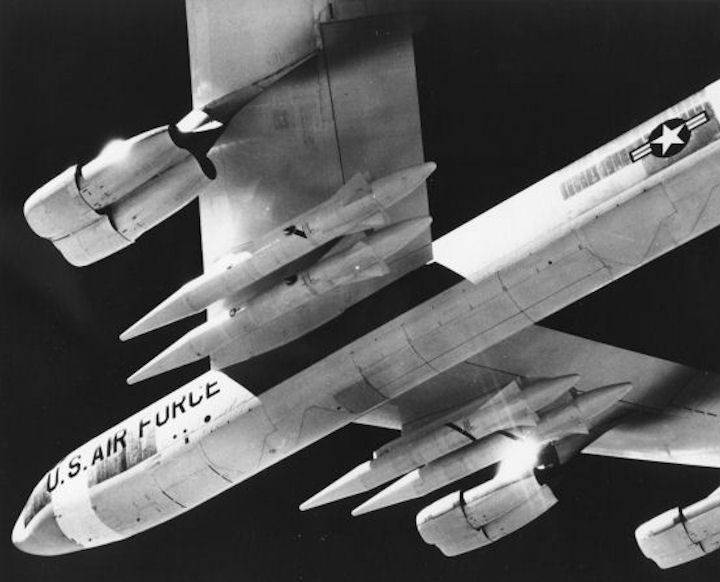
View from a different angle. Photo Globalsecurity.org
Regardless of the carrier and type of warhead, the flight program of promising missiles should look the same. The product was dumped at the cruising speed of the carrier at an altitude of several kilometers. Separated from the aircraft, it was supposed to “fail” on the 120 m in height, after which the tail fairing was reset and the first stage engine was started. Immediately after turning on the engine, the rocket was supposed to go into a climb with a given angle. The engine operated for 100 s, after which the first stage separated and the second stage engine was switched on.
With the help of engines of both stages, the WS-138A rocket was supposed to rise to a height of about 60 km. On the active part of the trajectory, the automatics determined the position of the rocket and corrected the course. After the rocket was raised to a given height and accelerated to a speed of about 2,8 km / s, the second stage was switched off and dropped. Further, the flight continued only combat unit. During the shooting at the maximum range, he could climb to a height of 480 km, after which he began to descend to his goal.
Soon after the start of the project development, Douglas began full-scale aerodynamic testing. The Eglin airbase (pcs. Florida) and the nearest polygons became a platform for them. WS-138A / GAM-87 missile models were shipped using regular media. At the same time, their interaction with the aircraft and its influence on its characteristics were determined. Also, layouts were carried out with the collection of necessary data. The first such test took place in January 1961, and the trials continued for the next few months. These checks allowed the existing hull and aerodynamic surfaces to be improved.
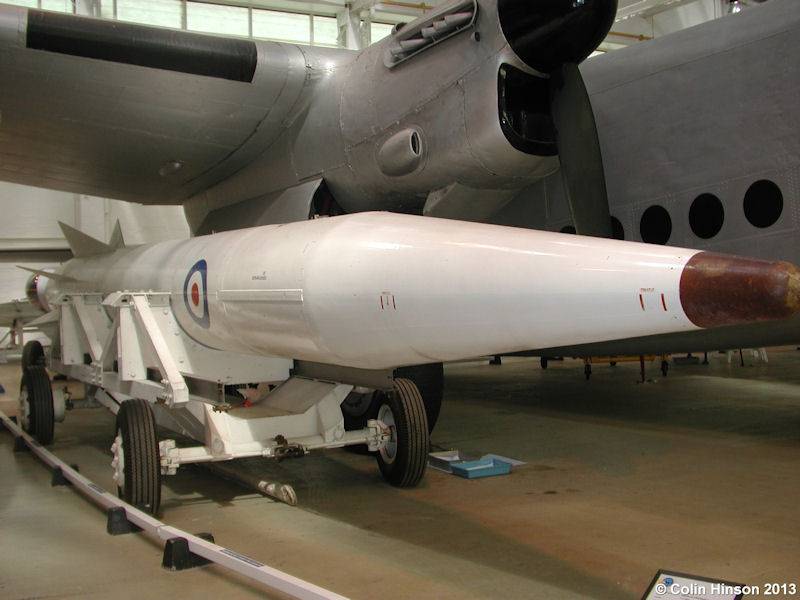
Model of a Skybolt rocket with British markings at the Royal Air Force Museum (Cosford). Photo by Globalsecurity.org
By spring of next year, the project was ready to launch full-fledged flight tests. 19 April 1962 of the year the B-52G aircraft for the first time dropped from the pylon the real XGAM-87 rocket, on board which was present all the standard equipment, except for the warhead. The rocket was supposed to fly towards the Atlantic Ocean. The first stage worked in the right way, but when the engine was ignited, the second one failed. The rocket could not continue the flight, the testers had to use its self-liquidator.
After investigating the causes of the accident and finalizing the project, the tests continued. 29 June held a second discharge. At this time, an experienced rocket could not start the first-stage engine. In the third launch of 13 September, the engine turned on, but the control systems failed. The missile deviated from the set course, and on the 58 second flight it had to be undermined in order to avoid falling outside the permitted area. On September 25, the fourth rocket used the first stage and turned on the second, but its engine stopped ahead of time. Flight to the calculated range was impossible. The next launch of November 28 ended in an accident. On the 4 second flight, the rocket lost contact with ground vehicles, and it had to be destroyed.
On December 22, 1962, the XGAM-87 Skybolt rocket made its first successful flight. On the sixth attempt, the prototype was able to correctly use both engines and bring the inert warhead to the required trajectory. During this test, the calculated characteristics of the range and accuracy of firing using the W59 warhead were confirmed.
However, by this time the fate of the project was decided. The military and political leadership of the United States no longer saw the point in continuing the work. At the same time, the administration of President John F. Kennedy found several reasons at once for abandoning the new missile. Factors of a technical, economic, military and political nature could have affected its fate.
First, the GAM-87 rocket looked, to put it mildly, unsuccessful. Of the six test flights, only one was successfully completed. No one could tell when the rockets will show the required reliability, and what the final cost of the program will be. In addition, the desired results were obtained in the field of ballistic missiles for submarines, which could take on the tasks of the Skybolt system. Finally, after the recent Caribbean Crisis, Washington wanted to show its desire for peace, and for this it was necessary to reliably abandon any project in the field of nuclear weapons.
In such a situation, the WS-138A / GAM-87 project did not have a single chance. In November, a crucial decision was made on 1962, and on December 22, J.F. Kennedy signed a decree on stopping the development of a new airballistic missile. Ironically, it happened on the day of the only successful test launch. However, the work was not stopped. By this time, the Douglas company and related enterprises had managed to produce a number of experienced rockets, and it was planned to use them in new tests to work out certain issues.
The decision of the US leadership to abandon the further development of the GAM-87 product angered official London. In accordance with the 1960 agreement of the year, these missiles were to enter service with the Royal Air Force and become perhaps their most powerful weapon. The rejection of the development, in turn, hit hard the prospects of British strategic nuclear forces. Countries were forced to start special negotiations, the purpose of which was to develop new plans for the joint development of the UK nuclear triad.
J.F. Kennedy held talks with British Prime Minister Harold Macmillan, which resulted in the signing of the Nassau Pact. In exchange for Skybolt aircraft missiles, the United States offered to supply UGM-27 Polaris products for submarines. The preliminary agreement was confirmed by a contract dated 6 on April 1963. Soon shipments of missiles began, thanks to which Britain was able to create the desired nuclear shield.
According to known data, tests of the remaining WS-138A / XGAM-87 missiles continued for almost the entire 1963 year. In June, the Pentagon introduced a new nomenclature of missile weapons, in accordance with which Skybolt was renamed AGM-48. Already under the new name, the available rockets made several flights. During these tests, there were successes and accidents, but they no longer affected the outcome of the work. With their help, various issues were studied, but the launch of missiles was no longer discussed.
An air-launched Douglas WS-138A / GAM-87 / AGM-48 / Skybolt ballistic missile could become the first model of its class to be adopted by the US air force. However, the presence of a mass of problems requiring solution, alternative developments and the political situation in the world led to the abandonment of the project and the whole direction. The new rearmament of the US Air Force's strategic aviation, which was launched shortly, was carried out with the help of cruise missiles.
On the materials of the sites:
http://designation-systems.net/
http://airwar.ru/
https://globalsecurity.org/
https://fas.org/
http://space.skyrocket.de/
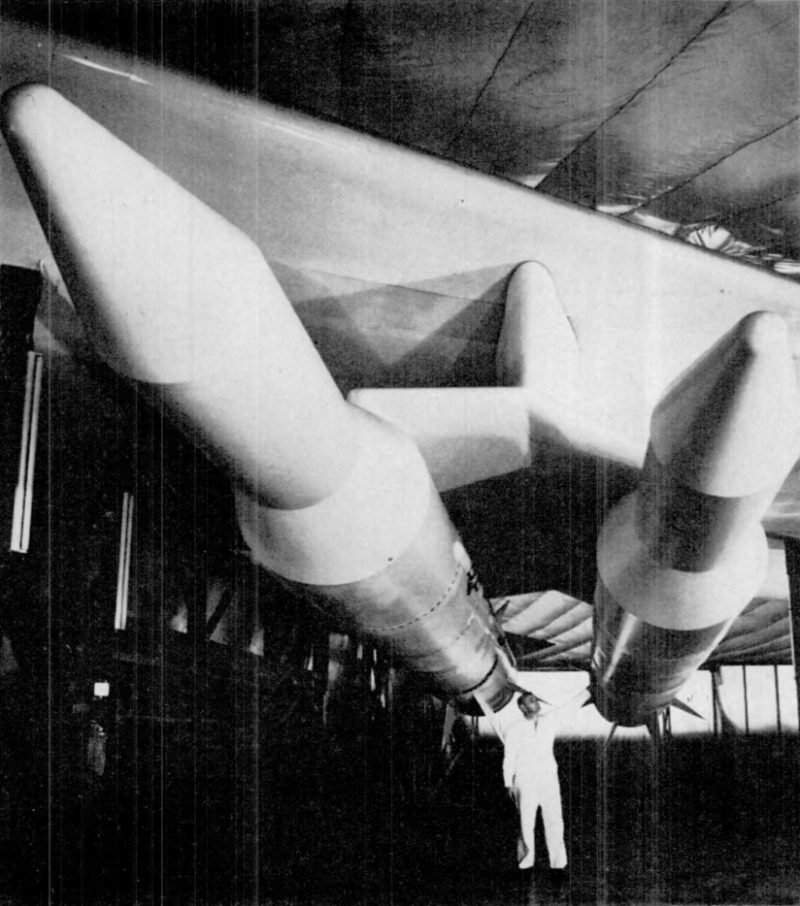
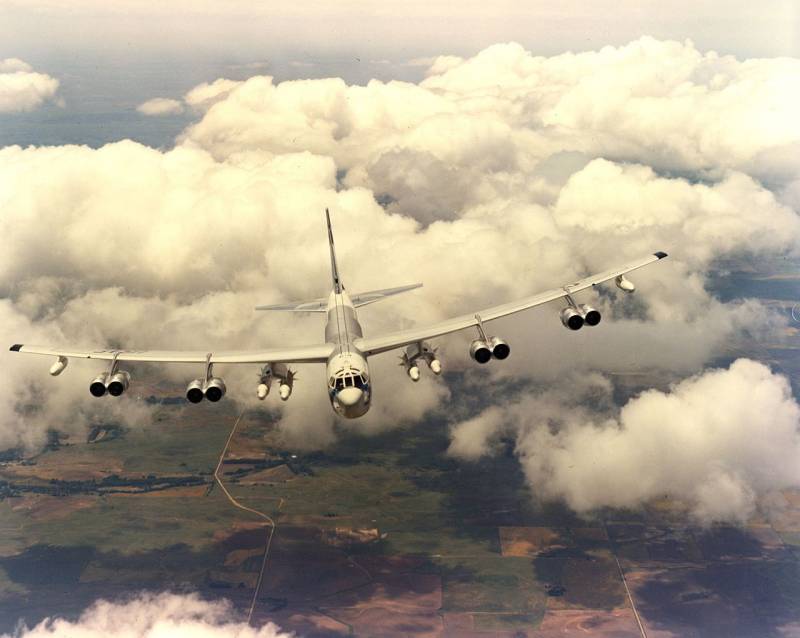
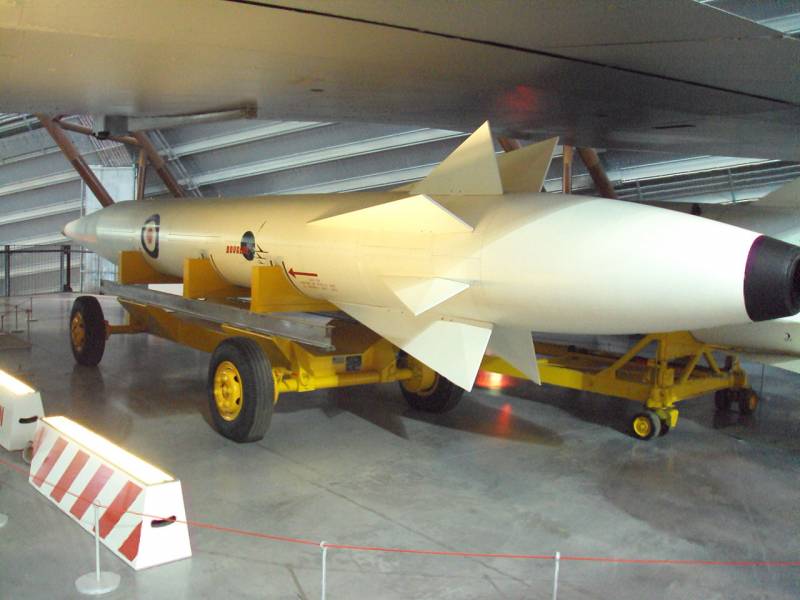
Information